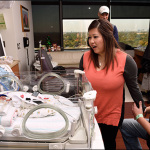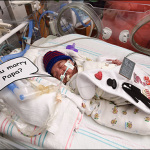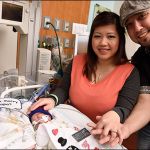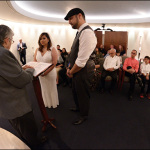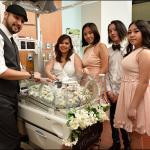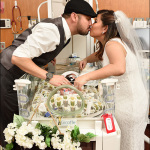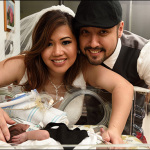 On September 8, 2011, Katy Haynes, a former neonatal nurse at Texas Children’s, became the patient family when her daughter, Maggie, was cared for at Texas Children’s neonatal intensive care unit (NICU).
On September 8, 2011, Katy Haynes, a former neonatal nurse at Texas Children’s, became the patient family when her daughter, Maggie, was cared for at Texas Children’s neonatal intensive care unit (NICU).
Maggie was diagnosed with a giant omphalocele, a condition in which the abdominal muscles do not close properly and the intestines push out into the umbilical cord creating a large sac. She spent two weeks in the NICU.
“The staff started out as my colleagues and in the end, became the caregivers to our sweet Maggie,” Haynes said. “I truly owe Maggie’s short NICU stay to the great team that took care of her. They trusted me as a nurse and her mother, and worked with me to create a care plan that would work both in the NICU and at home.”
Today, Maggie is a thriving 5 year old. Despite having abdominal surgery, she is a strong, compact, muscular powerhouse. Haynes say her daughter excels at gymnastics and anything that she sets her mind to accomplishing.
The Haynes family is one of 10 NICU families featured in the second installation of the Wall of Hope, a permanent photography exhibit that was unveiled during a special ceremony on February 9 at Texas Children’s Pavilion for Women. The exhibit will be housed on the fourth floor of West Tower.
“The Wall of Hope was created to inspire and give hope to families who currently have a baby in the NICU at Texas Children’s,” said Family Centered Care Specialist Tamara Thrasher-Cateni, who worked with the Newborn Center Family Advisory Committee (NCFAC) and Facilities to coordinate the Phase II initiative and unveiling ceremony. “Babies born prematurely or with health issues can spend weeks and months in the NICU, so this exhibit is a way to celebrate all they have overcome.”
The Wall of Hope exhibit features 10 portraits chronicling each patient’s challenges throughout their time in the NICU and showcasing how they are thriving today.
“This event was emotional, informative and refreshing,” said Erika-Michelle Best, whose daughter, Nalah, was treated for osteogenesis imperfecta, also known as brittle bone disease, in the NICU for 14 weeks. “It is refreshing to know that you’re not alone. It is also an honor to know Nalah’s story can help someone else, uplift someone, brighten their day and most importantly give them hope.”
The unveiling ceremony also included remarks from Texas Children’s Chief of Neonatology Dr. Gautham Suresh, NICU Nursing Director Heather Cherry, and Newborn Center Vice President Judy Swanson.
“Looking at the photographs of our NICU graduates, listening to the parents speak about their children with pride and describing how much joy the children brought to their families, I am reminded about the true reason why all of us come to work every day at Texas Children’s,” Suresh said. “I feel privileged to serve and give our patients and their families the best care possible. I am humbled by the strength and resilience of the children and their families.”







